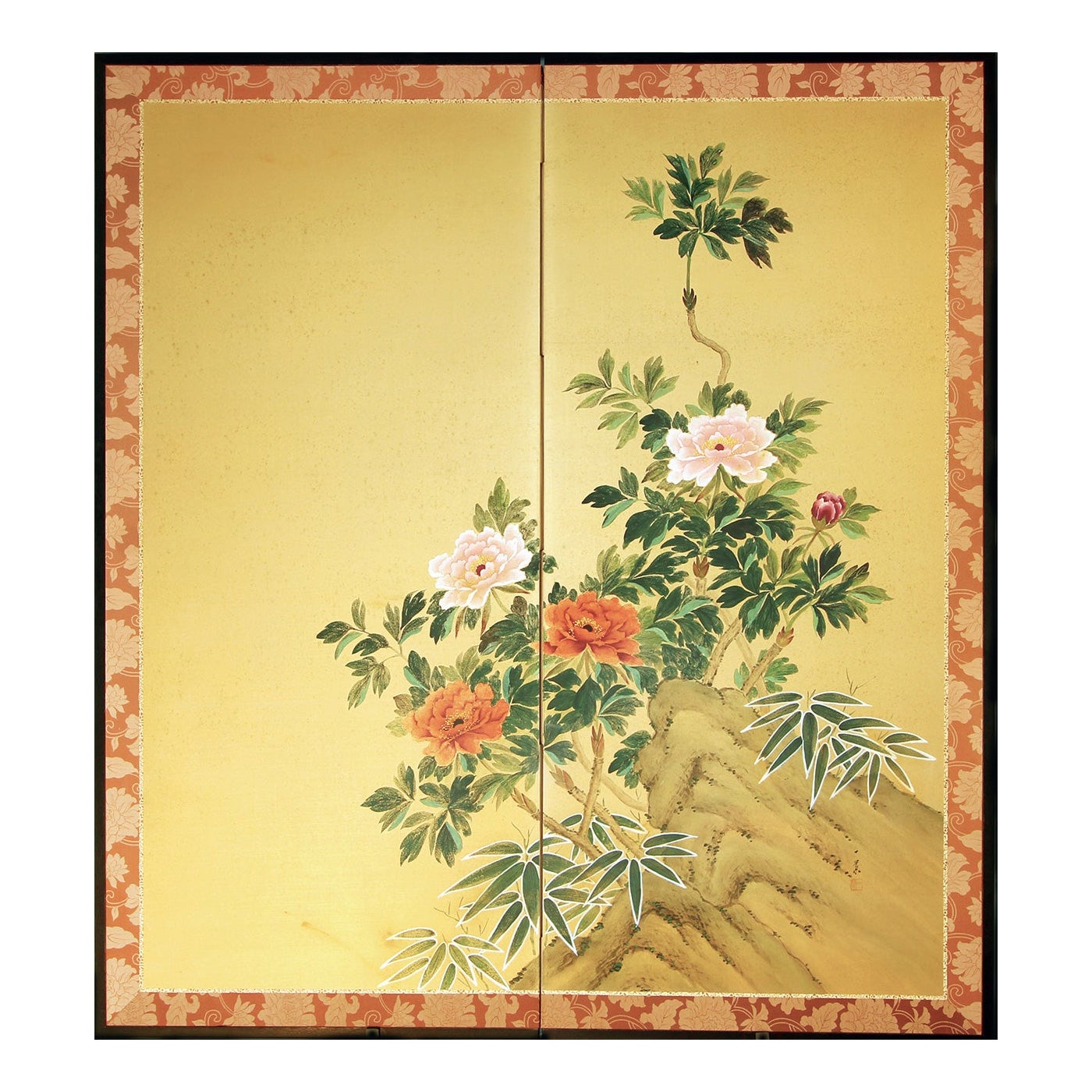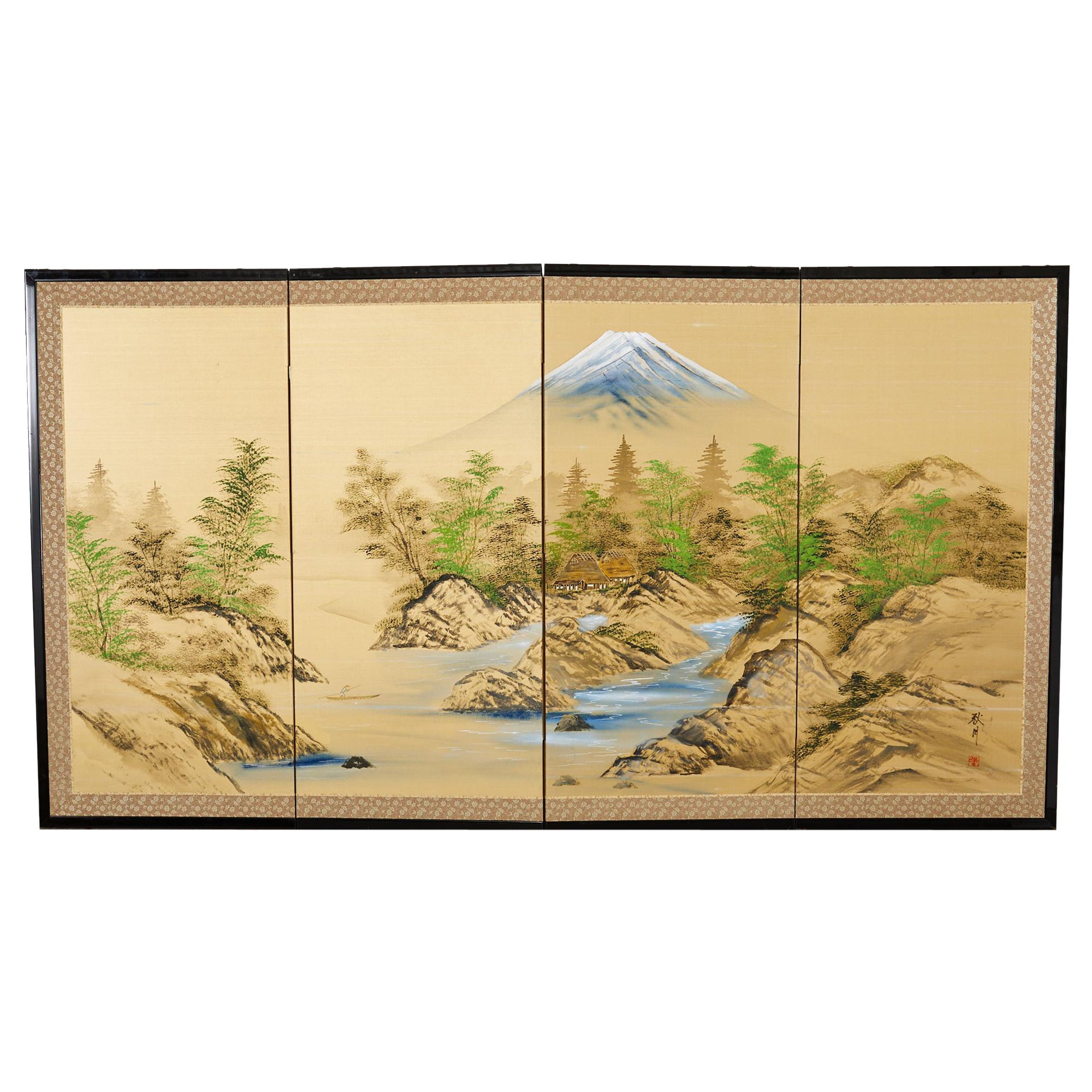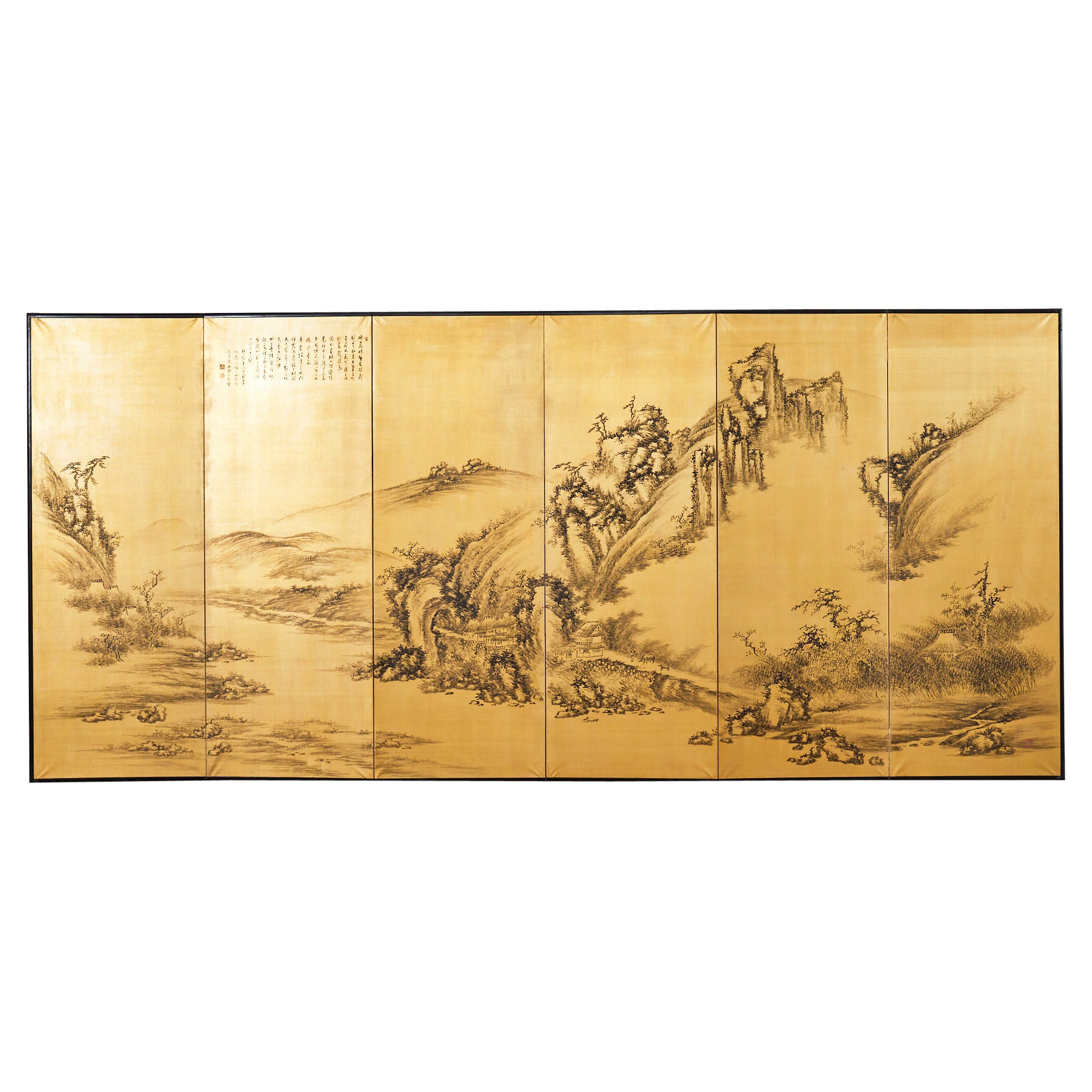Items Similar to Circa 1950 Japanese Screen. Surrealist Nihon-ga Landscape.
Want more images or videos?
Request additional images or videos from the seller
1 of 8
Circa 1950 Japanese Screen. Surrealist Nihon-ga Landscape.
About the Item
Anonymous
Surrealist Landscape
Showa era, circa 1950
Four-panel Japanese Screen, pigment on paper.
A post World War 2 Japanese nihon-ga screen depicting a Surrealist landscape. The fantastical landscape is populated with tree-like limbs and forms within which countless eyes, faces and bodies have been created. Creating faces from unusual juxtapositions of objects has been a tendency in painting for hundreds of years though this work owes its inspiration to the western Surrealist movement of the mid-war period. The highly unconventional and seemingly bizarre imagery celebrates the power of the unconscious, depicting a scene and ideas that defy logical sense. The organic and biomorphic forms create an atmosphere deeply reminiscent of a dream.
Although the screen is unsigned the highly emotional and experimental subject matter points to the Kyoto based Pan-real Art Association. Four-panel folding screens were a relatively common exhibition size canvas for the immediate post-war period and were often left unsigned. We haven’t been unable to unearth anything of the exhibition history relating to this particular screen, though it was certainly painted with exhibition in mind. The Pan-real Art Association was formed in 1948 and marked a sudden eruption of desire for subjective expression, suppressed during the war, following Japan's military defeat. The founding members, young individuals trained in nihon-ga at the Kyoto Municipal School of Painting, aimed to liberate the motifs in traditional Japanese nihon-ga and actively incorporate Western avant-garde expressions.
Works from the very early Pan-real era reflect a significant influence of Surrealist painting, exhibiting fantastical and often mysterious qualities. The group was dedicated to pursuing reality in painting through experimental methods driven by intense internal emotion and expanding the possibilities of Japanese nihon-ga in terms of subject matter and materials. Another focus was on impasto layering of pigments, attempting to infuse nihon-ga with some of the qualities found in oil painting. In this particular work the pigments have been laid on the paper surface thickly enough that knife strokes or texture scratches are visible throughout.
- Dimensions:Height: 69 in (175.26 cm)Width: 109 in (276.86 cm)Depth: 0.75 in (1.91 cm)
- Style:Showa (Of the Period)
- Materials and Techniques:
- Place of Origin:
- Period:
- Date of Manufacture:Circa 1950
- Condition:Wear consistent with age and use.
- Seller Location:Kyoto, JP
- Reference Number:1stDibs: LU2472338780912
About the Seller
5.0
Recognized Seller
These prestigious sellers are industry leaders and represent the highest echelon for item quality and design.
Gold Seller
These expertly vetted sellers are highly rated and consistently exceed customer expectations.
Established in 2001
1stDibs seller since 2016
60 sales on 1stDibs
Typical response time: 6 hours
- ShippingRetrieving quote...Ships From: Kyoto, Japan
- Return PolicyA return for this item may be initiated within 10 days of delivery.
More From This SellerView All
- circa 1930 Japanese Silver Screens by Isoi Joshin, Flowers of the Four SeasonsLocated in Kyoto, JPFlowers of the four seasons Isoi Joshin (1883-1964) Pair of six-panel Japanese screens Ink, pigment, lacquer and silver leaf on pa...Category
Mid-20th Century Asian Showa Paintings and Screens
MaterialsSilver Leaf
- Japanese Screen Painting, Cat & Pumpkin Patch. Showa Era, 1940sLocated in Kyoto, JPChuichi Konno (1915-2006) Cat and Pumpkin Patch Showa period, 1940s. Folding screen in two-panels. Painted on paper with mineral pigments and gofun. Sign: Chuichi Sea...Category
Vintage 1940s Japanese Showa Paintings and Screens
MaterialsPaper, Wood
- Japanese Screen Painting, circa 1700 'Horses' by Kano TanshinLocated in Kyoto, JPHorses Kano Tanshin Morimasa (1653-1718) Two-panel tea-ceremony Japanese screen or furosaki Ink on gold leaf, late 17th-early 18th century Measures: H 55 cm x W 182 cm The Kano school was closely aligned with the warrior class in Japan. The samurai, who lived in a closed and rigid hierarchical society established by the Shogunate, were drawn to the energy and freedom horses symbolize; Kano school artists commonly depicted the equine creatures as they are here, in unfettered and carefree family groups. China originally introduced horse paintings to Japan; the works typically focused on capturing the essence of horses in their various environments and often involved integrating human figures into the images. Kano Tanshin Morimasa (1653-1718) was the son of Kano Tanyu...Category
Antique 1690s Japanese Edo Paintings and Screens
MaterialsGold Leaf
- Circa 1700 Japanese Screen Pair, Cranes & Pines, Kyoto Kano SchoolLocated in Kyoto, JPPines and Cranes Anonymous. Kyoto Kano School. Late 17th/early 18th centuries, circa 1700. Pair of six-panel Japanese folding screens. Ink, gofun, pigment and gold leaf on paper. This bold composition presents two pine trees extending to the left and right across a gold leaf background. One tree is silhouetted against a green ground, golden clouds obscuring its true size, the other stretches across a stylized waterway. The pines are paired with Manchurian cranes with red crests and snow white plumage. Both have been highly auspicious motifs in East Asia since Chinese antiquity. Here the artist utilized fluid and instinctive ink brushstrokes to define the trunk, branches and tail feathers, in strong contrast to the precision and sharp angularity of the crane’s legs and beaks. The adoption of this vast metallic painting support required an unerring sense of design and composition, so that the negative space surrounding motifs could imply context for the otherwise floating pictorial elements. The brushwork detailing the trunks of the pines, the exaggerated dimensions of the pine trees and the strength and dynamism of the composition are all reminiscent of Kano Eitoku...Category
Antique Late 17th Century Japanese Edo Paintings and Screens
MaterialsGold Leaf
- Circa 1900 Japanese Screen. Cherry Blossoms in Moonlight. Meiji period.Located in Kyoto, JPKobayashi Shosen (1877-1946) Cherry Blossoms in Moonlight Six-panel Japanese Screen. Ink, color and gofun on paper. The image depicts a stunning scene captured on a six-panel Japa...Category
Antique 1890s Japanese Meiji Paintings and Screens
MaterialsPaper
- Japanese Screen Pair, circa 1730, Peacocks and Phoenix, Kano SchoolLocated in Kyoto, JPPhoenix and Peacocks. A pair of six-panel Japanese folding screens by Tsunetake Yotei (n.d.) First half of the 18th century. The signature reads 67 year old Tsunetake. The seals read: -Tsunetake no in, -Yotei, -Seishin Dimensions: Each screen – H. 69” x W. 149” (176 cm x 378 cm) A pair of Kano Grand Picture (Waga) screens depicting phoenix and peacocks rich with symbolic meaning. Dating to the first half of the 18th century, from the Kobikicho Kano school in Edo, this pair of folding...Category
Antique Early 18th Century Asian Edo Paintings and Screens
MaterialsGold Leaf
You May Also Like
- Japanese screenBy Japanese StudioLocated in Brescia, ITTwo-panel screen of Rinpa school painted with mineral pigments on silk and rice paper. It depicts colorful peony flowers. This is the flower of spring, symbolizing success and pro...Category
20th Century Japanese Showa Paintings and Screens
MaterialsSilk, Paper
- Japanese Showa Four Panel Screen Mount Fuji LandscapeLocated in Rio Vista, CAGorgeous Japanese Showa period four panel byobu screen depicting a wooded valley landscape with a rustic dwelling near mount Fuji. The screen is decorated with fantastic, vivid blue ...Category
20th Century Japanese Showa Paintings and Screens
MaterialsBrass
- Japanese Style Four Panel Screen Turquoise River LandscapeLocated in Rio Vista, CADistinctive Japanese style four panel folding Byobu screen depicting a turquoise river mountain landscape. The painting is titled "One Sail Following The Wind" on the top left side. Appears to be a Korean...Category
20th Century Korean Showa Paintings and Screens
MaterialsWood, Paper
- Japanese Showa Four Panel Screen Serene Solitary Boatman LandscapeLocated in Rio Vista, CAPeaceful Japanese Showa period four panel folding byobu featuring a solitary boatman in a canoe in a lush mountain river landscape. The serene setting is painted with vibrant green p...Category
20th Century American Showa Paintings and Screens
MaterialsBrass
- Edo Landscape Japanese Folding ScreenBy Japanese StudioLocated in Brescia, ITRefined work by a painter from the first half of the 19th century, from the landscape of the "Rinpa" school by a painter from the end of the 18th century, the Rinpa school. Six panels painted in ink on gold leaf and "gofun" on vegetable paper. The flowers are made with the "gofun" technique, natural or pigmented white oyster powder. Rinpa is one of the major historical schools of Japanese painting. The style was consolidated by the brothers Ogata Korin (1658–1716) and Ogata Kenzan (1663–1743). This folding screen has a very clean design that leaves plenty of room for the beautiful golden landscape. It comes flat and you can easily hang it with our hooks. Lucio Morini...Category
Antique 18th Century Japanese Edo Paintings and Screens
MaterialsGold Leaf
- Japanese Style Showa Six Panel Screen Chinese Gilt Mountain LandscapeLocated in Rio Vista, CAImpressive Japanese style Showa period six-panel byobu screen featuring a serene Chinese mountain landscape along a waterway over a dramatic gilt background. The painting is accompan...Category
20th Century Asian Showa Paintings and Screens
MaterialsWood, Paper
Recently Viewed
View AllMore Ways To Browse
Large Asian Room Divider
20th Century Silk Painting Japan
Antique Gold Wall Feature
Porcelain Vase Bird Lamp
2 Small Upholstered Chair
Rush Turned Leg Chair
Armoire With Mirror And Shelves
Antique Wood Swan
Antique Chinese Scholars Objects
Surface Mount Spotlights
Outdoor Pair Armchairs
Large Vintage Library Table
Open Bookcase Wood Wall
Double Sofa Bed
Metal Console With Shelf
Sweden Dressing
Splash Lamp
Deer Box





